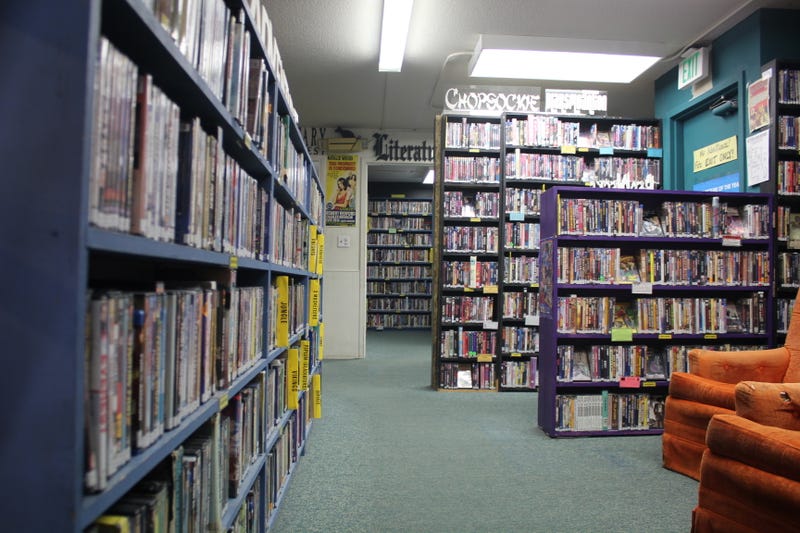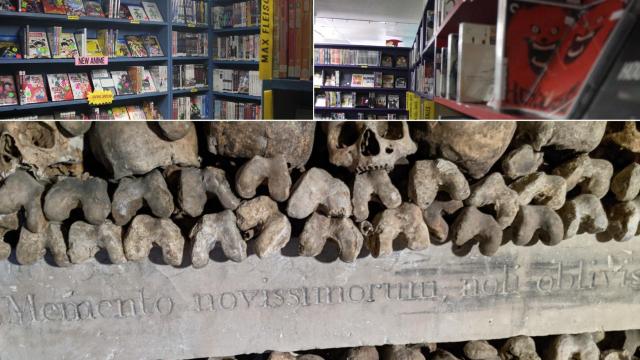There are few places in this world where dead things are offered such a promoted place among the living. If I had to arrange my mind to any, my first thought lands on the Catacombes de Paris, the old quarries turned morbid gallery for the shelves of anonymous bones. In that enormous memento mori, the skulls of long-dead Parisians are the mantle to innumerable femurs and tibia, each bearing the marks of their original owner.
There is no message to a single bone, but together, it’s as if each of those skulls screams in unison “Remember me.” Along the path through the catacombs, one sign in Latin reads “Memento novissimorum, noli oblivisci.” In a loose English translation, it says “Remember the last, do not forget.”
Scarecrow Video is the Catacombes of the cadaverous world of physical media, though it’s a much more entertaining and rewarding place to be than the melancholic tunnels beneath Paris. Every inch of the shop is covered head to floor in DVDs and VHS. There are aisles dedicated to anime, spy movies, chopsocky, and even more esoteric genres. The foreign film section has titles from countries where the film culture gets little to no attention, like Eritrea. There are more than 146,000 titles among those stacks ranging from recent box office hits to the bizarre, such as an old training video for how to use Microsoft’s Windows 95 hosted by Friends cast members Jennifer Aniston and Matthew Perry.
Yes, that exists, and as Scarecrow Video’s President and Treasurer Kate Barr (if you were curious, no, there’s no relation) told me in a phone interview earlier this month, it’s just as hilarious and bizarre as you could imagine. Scarecrow is the only video rental store left in all of Seattle, Washington.
And while you can’t mail-order a fingerbone from Paris’s famous mortuary, you can request one of Scarecrow’s DVDs through the post. The shop, itself a nonprofit cultural site since 2014, is the last independent shop supplying the option for older physical media, namely VHS and DVDs, to the nearly 734,000 people living in the city. This month, the small store—with its labyrinth of DVD-lined shelves—became one of the last services offering physical DVD rentals to the entirety of the U.S.
“For people who are looking for a very specific title that they can’t track down, people who are movie lovers or get obsessed with a particular director or particular actor, and they want to watch their whole filmography, we’re the place that’s gonna have it,” Barr said.
Scarecrows DVD-by-mail service went live earlier in September as part of a multi-year fundraising initiative to breathe new life into the small business. The company spent more than $US350,000 creating a new website and developing a program that would allow them to ship DVDs to all 50 states. In a stroke of what may be either luck or impending reckoning, Netflix officially declared the last DVDs for its disc-rental service would be snuggling into subscribers’ mailboxes this month. Barr said their original announcement date was back in April before it was delayed, around the same time Netflix first announced it was retiring its DVD service. The last of Netflix’s DVDs went out this week.
In comparison, the small shop’s DVD-by-mail service is more expensive than Netflix’s old offering with a flat $US12 shipping fee, and while Scarecrow has far more titles available than Netflix did at its height, Barr said they have fewer copies of each movie or show. Customers have a limit of six DVDs at a time, and everything’s shipped in hard plastic to preserve the integrity of each disk. Customers, for their part, are expected to care for each copy like they’re a treasure. In that way, Netflix’s model is far different from what Scarecrow wants to offer. Also, you don’t have to worry about sharing a password.
“Netflix was a loss leader,” Barr explained. “Our collection is so unique. We don’t have, you know, 500 copies of the same movie. We have one, maybe two copies of various movies, maybe more if they’re popular. We had to figure out how to do this in a way where we basically don’t just hemorrhage our collection.”
More than anything, the service is for cinephiles, those who want to watch something they can’t easily get or struggle to find on any current streaming service. It’s for folks who want to watch a movie with the serenity of no ads, who find the limitation of having only a certain number of movies or shows to watch at a time—in many ways—freeing.
Is Physical Media Here to Stay?
Though the number of video stores has dwindled in the last few decades, there are some companies holding the torch for physical media. Scarecrow isn’t the first small shop to do rent by mail either. The Chicago-based Facets has also had its own rental service for edging on two decades while the small shop 20th Century Flicks located in Bristol, UK also has a small mail service.
The last big rental service for physical DVDs remains Redbox with their big disk vending machines still found outside the odd 7-Eleven or gas station. The company itself was bought out by Chicken Soup for the Soul Entertainment a year ago for $US375 million, and in an email to Gizmodo, the company claims it still has 29,000 kiosks across the U.S. and 40 million active loyalty members still going back for the latest hits. CSSE has said it wants to cut down on costs in order to make up for its Redbox purchase.
But while there are still options to find a disk of the latest releases, there are far fewer opportunities to discover old, forgotten, or niche media. Services like The Criterion Channel and Turner Classic Movies keep some older films in circulation, but it’s not nearly enough to encompass the whole of the world’s media production for the past century—not even close.

The problem, as always, is licensing. It’s a costly and time-consuming endeavour to find each and every rights group and then pay them for the privilege of airing some forgotten foreign flick. Licensing deals on physical media that’s already been manufactured are all taken care of. And yes, there is piracy, but even the largest online film archives cannot find everything, especially stuff that hasn’t been digitized. Hell, there’s more cross-pollination between pirate libraries and rights holders than those companies would like to admit.
Video rental services don’t necessarily have to worry about rights. After all, you’re paying to rent a copy of the film, not the right to show that film in public. Companies like Netflix are also beholden to their bottom line. They won’t pay to license a black-and-white indie film from post-war China if few are likely to care.
“For us, that’s just not a criteria,” Barr said. “Once it’s in our collection, it’s in our collection, we don’t go through and prune it.”
But there is an issue with physical media, one that gets worse every year. DVDs and VHS tapes degrade over time. You have nonprofits working to defeat what’s known as the “magnetic media crisis” by digitizing as many cassettes as they can. The Library of Congress and other groups have worked to digitize movies to add to the permanent collection, but the selective nature of preservation naturally leaves out the weird and the odd, the indie and the forgotten.
Barr said her store has worked to get grants to help digitize some of the rarer parts of Scarecrow’s collection to places like the Internet Archive, but even then, digitizing isn’t a magic bullet. Even digitized content needs to evolve, whether that’s moving to a new hard drive or to a newer file format. The Library of Congress has far more content than Scarecrow, but the U.S.’s largest archive isn’t in the habit of mailing you content on demand.
Even as I’m just one of the millions who remember Blockbuster Video fondly, we all have to admit streaming is here to stay—at least as long as some new services don’t come and wreck the entire home-movie paradigm once again. Barr said that she believes physical media can still have a place today, even if many people have long eschewed their DVD player altogether.
“We at Scarecrow Video, every single person at Scarecrow Video streams, in addition to watching heaps and heaps of Blu-rays and DVDs and VHS because it’s just a part of our viewing culture now,” she said.
If you put Netflix, Amazon, and Hulu together you might have 42,000 titles on offer, including Originals, there are many, many more DVDs in Scarecrow’s collection, and a little more than 106,000 of those are available for the by-mail rental service. Unfortunately, you can’t get your hands on that weird Friends Windows 95 how-to, or any other rare DVD or cassette unless you happen to live near enough to rent in person. Those special DVDs and all VHS tapes have to stay with Scarecrow simply because they’re just too valuable to trust to the whims of USPS. Still, Barr said Scarecrow is going to keep it up and see how far they can take their small enterprise. And hey, there should be something special left for the people who make the trek to the store.
“Unless we all fall into the ocean, we’ll still be here,” Barr said.
Memento novissimorum, indeed.
